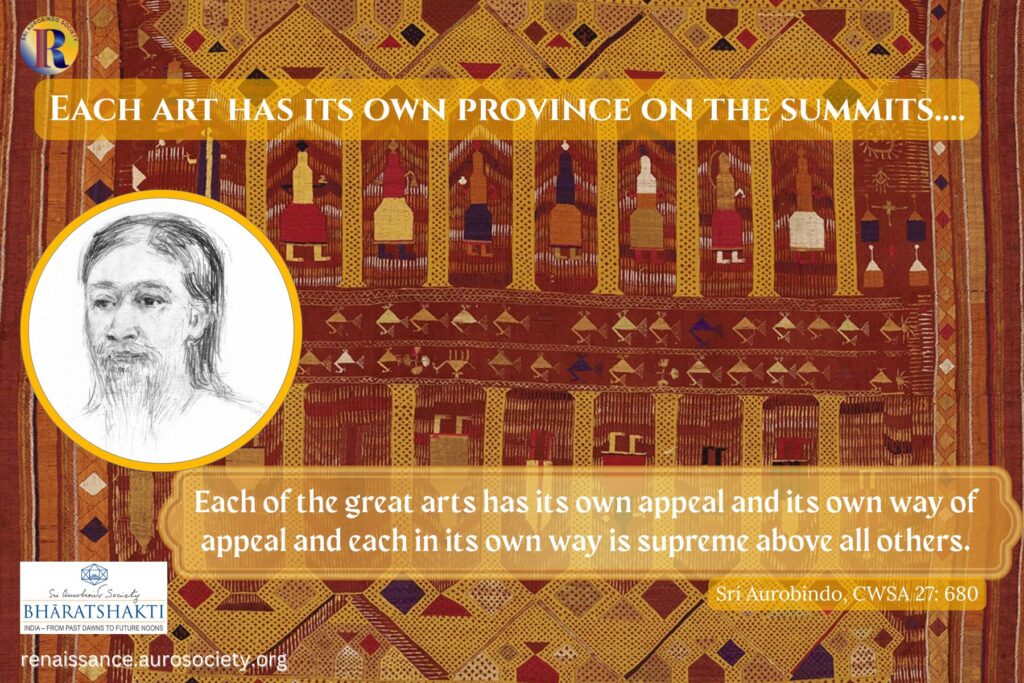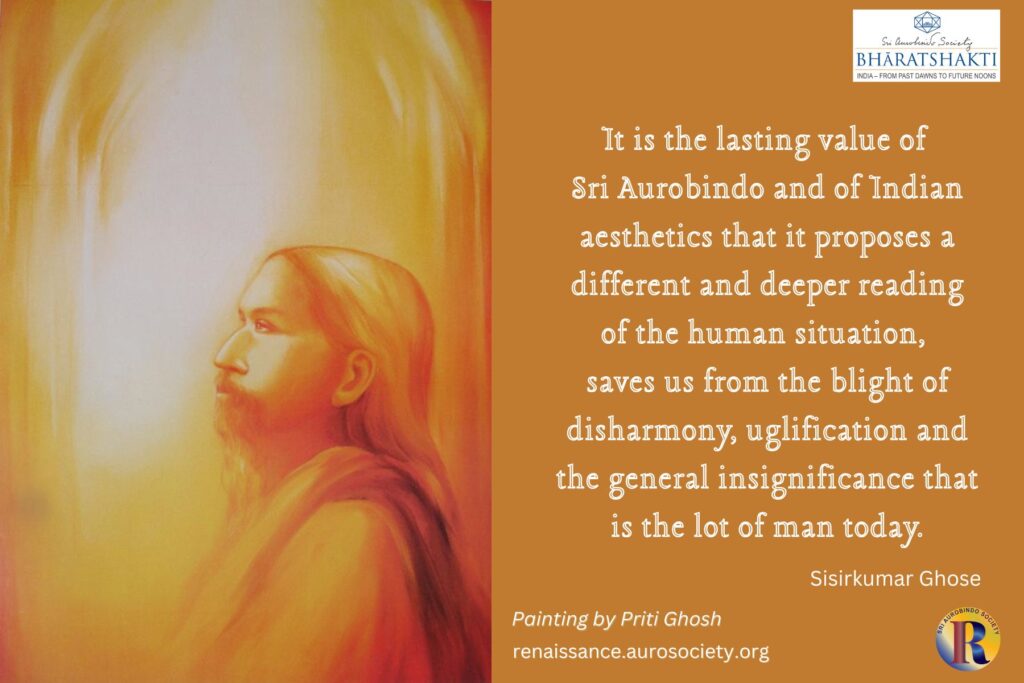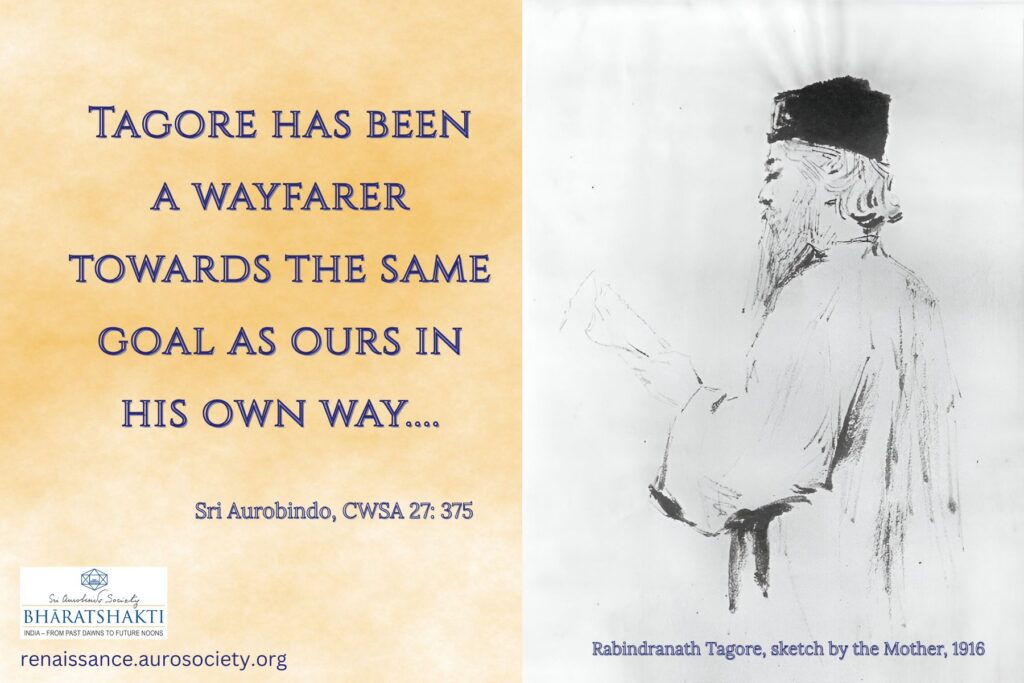Volume V, Issue 1
Author: Mangesh V. Nadkarni
Editor’s note: As part of our exploration of symbolism in Sanatana Dharma, we now take up a study of Savitri. Under the poem’s title, Sri Aurobindo gave a brief description “A Legend and a Symbol”. What is this legend? And what does this epic poem of Sri Aurobindo symbolize? To explore this, we begin a series featuring an important writing of Mangesh Nadkarni. Here he presents some important comparisons between Sri Aurobindo’s Savitri and the original legend found in the Mahabharata.
We present – in two parts – excerpts from Chapter 2 of the author’s book titled Invitation to Sri Aurobindo’s Savitri. The book is a collection of 31 talks that Mangesh Nadkarni had delivered at Sri Aurobindo Society in 1995. We will continue the series in the subsequent issues of Renaissance.
Also, we have made a few minor grammatical and formatting changes for the purpose of this digital presentation.

On the title page of Savitri you will find a description which calls it “A Legend and a Symbol”. The legend, of course, is the story of Satyavan and Savitri, known to all of us in its Puranic and popular version. The original story goes back to the Mahabharata, where the Pandavas are spending a lot of time in the forest. Yudhishthira is depressed that he has been living a life of righteousness and still has to undergo all these privations, defeats.
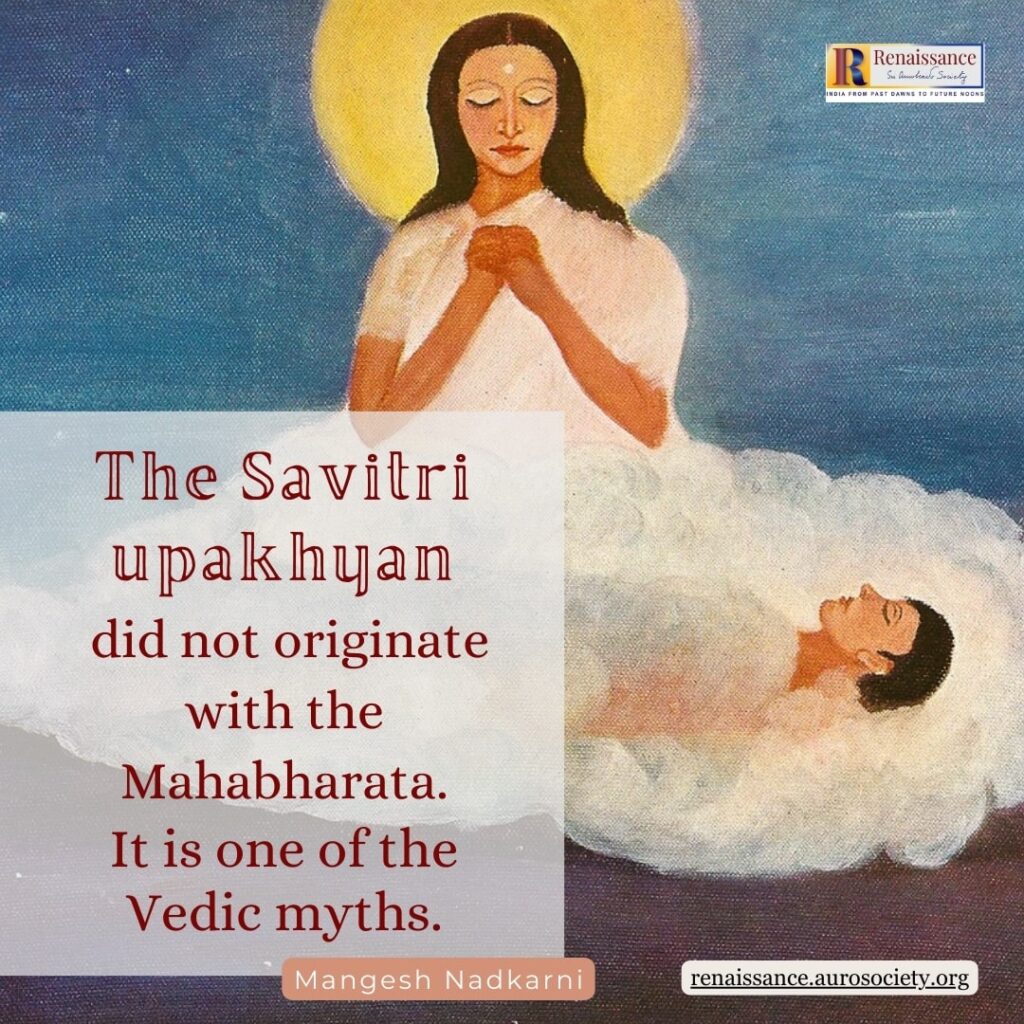
The Mahabharata Legend
On one occasion, when Rishi Markandeya comes and visits them, Yudhishthira asks him: has there ever been a parallel to my case? We have been five brothers living such a virtuous life, and yet we have to suffer so much humiliation, privation, defeat. Markandeya obliges and tells him the story of Rama: Rama was also like you, and yet look at his life. He had to spend 14 years, lose his wife, and fight this war against Ravana, etc.
Yudhishthira is not satisfied. He asks: has there been a case like Draupadi’s, a woman of such an exceptional virtue, and who yet had to suffer disgrace and humiliation recently? Jayadratha tried to abduct her and she had to be rescued. Do you know any parallel to this at all? Markandeya then tells him the story of Savitri. This is how the Savitri upakhyan comes into the Mahabharata.
But the Savitri upakhyan did not originate with the Mahabharata. It is one of the Vedic myths.
When a Vedic myth is taken up in the Puranas, most often it loses its original point and gets a popular body. The story of Savitri as we know it is primarily a saga of a righteous woman’s chastity and how much merit, force, power she can acquire through chastity. In the popular mind Savitri is associated with that kind of thing.
Very often my modern friends wonder why Sri Aurobindo, writing an epic for future humanity, chose the story of Savitri. This again in some sense is a symbol of male chauvinism, where you are only talking about a wife’s duty and chastity towards her husband. Why couldn’t Sri Aurobindo for a change reverse it and talk about a husband’s duty towards his wife, a husband’s chastity towards his wife, and how great merit it accumulates?
People who quibble on this point do so because they haven’t taken the trouble of reading Savitri. It has nothing to do with chastity, whether it is a husband’s or wife’s. This emphasis on chastity as a primary virtue of the Savitri story is a later popular edition.
Man’s Aspiration for Immortality
In the Vedic myth it primarily comes through as man’s aspiration to immortality. Man’s soul which descended here, is caught up in Ignorance. This is the purusha who is caught up here. And the Supreme Prakriti, the Divine Mother, has to come down to rescue this purusha. Ultimately, it is man’s aspiration for immortality that the Savitri story was all about in the Vedic myth.
But in the Puranas, the emphasis of the story got changed. With the passage of time and perhaps because of the typical male mentality, the story further degenerated into a kind of argument for a wife’s behaviour towards her husband. The wife should be like Savitri!
These are all things which somehow have accumulated around the Savitri myth. But why did Sri Aurobindo take up the story? What did he find in this story? Love conquering death is a theme that deeply fascinated Sri Aurobindo. Death stands for all limitation, it stands for all negation. It doesn’t simply stand for disintegration of the human physical frame—death symbolises all these things. Love is the highest power that has come down to earth. And it is only through love that death can be conquered.

Love Conquering Death
This was the great theme that Sri Aurobindo took up. And if you look at Sri Aurobindo’s completed plays, like Perseus the Deliverer, The Viziers of Bassora, and Rodogune, all these plays of Sri Aurobindo are variations of the same theme: love conquering death. Sri Aurobindo found it so fascinating that he wrote two other works on the same theme.
The first he wrote when he was a young man of about 22 or 23, a poem called Urvasie. Then later, at about 27 years of age, he wrote a poem called Love and Death.
He took Savitri after this, but all these three have the same theme. Looking at the development of the theme in these three stories, we find why Sri Aurobindo was fascinated by the story of Savitri.
Sri Aurobindo’s Earlier Poems
In Urvasie, Pururavus, a human mortal of this earth, falls in love with an apsara. When this apsara goes back to her world, Pururavus, who madly loved her, goes looking for her, and finally ends up in the heavens, where Urvasie belongs. The gods there are kind. They say, all right we shall grant you your love on one condition. But you must be willing to forego your life on earth and also be willing to come and stay here in the heavens.
Pururavus is so madly in love, he thinks it is a good bargain. Anyway, who wants life on earth, where electricity fails, where there is garbage, problems of all kinds, we have to pay taxes, please corrupt officials and so on? In heaven there are no officials, there is no sunset, there is no electricity, no bills to pay and so on. So he prefers heaven.
In Love and Death we see the repetition of the same theme but with a slight modification. This time the beloved, whose name is Priyumvada, is bitten by a snake, and she is carried to the patala-loka. And Ruru goes in search of her to patala, and the powers that be do recognise that he has a valid case. They say, all right, we are willing to give you back Priyumvada on one condition: you have to forego half the life span of your life on earth. Wonderful, he says, I’m more than happy to do it.
Savitri’s Insistence
In Savitri, the God of Death is willing to offer Savitri and Satyavan a special heaven. But Savitri is not willing to make a compromise. She says, I want to go back on earth, I want to realise the fulfillment of love here on earth. This is Savitri’s insistence. And Sri Aurobindo found this feature, the insistence on realisation of all human dreams of perfection on earth, especially attractive.
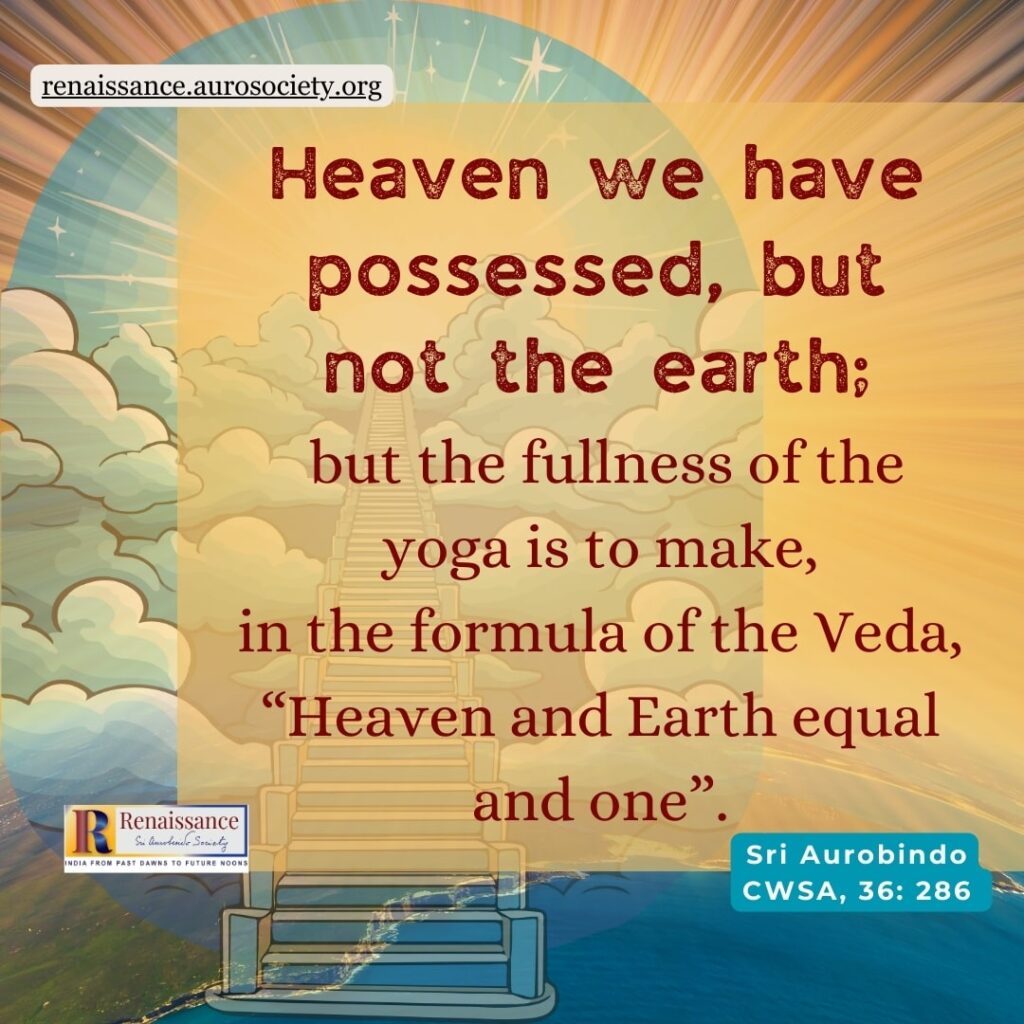
As we know, the Mother first came to Pondicherry in 1914. And during the First World War she had to go back to Paris, and then she went to Japan. During that period, in one of the letters to the Mother (dated 20 May 1915), Sri Aurobindo says,
Heaven we have possessed, but not the earth; but the fullness of the yoga is to make, in the formula of the Veda, “Heaven and Earth equal and one”.
~ CWSA, Vol. 36, p. 286
The aim of his Yoga is to bring perfection here on earth.
This has been Sri Aurobindo’s great emphasis. There has been no philosopher who has been a greater materialist than Sri Aurobindo.
Sri Aurobindo accepts that even if God has to come down here on earth, he has to accept the limitations of matter, he has to wear a form made of matter. For Matter for him is not an antithesis of Spirit. Matter is also another form of Spirit, of the Divine.
This emphasis that the Savitri story implicitly contains of the value of life here on earth, that is what must have attracted Sri Aurobindo a great deal. And that is why he decided to take this up as a framework for the great epic he was going to write.
Also read what Prema Nandkumar writes on
Sri Aurobindo’s and Rishi Vyasa’s Savitri
Comparison with the Mahabharata’s Legend
If you take up the Mahabharata’s Savitri story, which Vyasa narrates with great elegance, the entire story takes 700 lines. Sri Aurobindo’s epic Savitri follows the same story with even a little fewer details.
He has omitted what happens to Satyavan and Savitri after Satyavan returns from the kingdom of Death, how they meet their parents, which in the original story takes up to one third of the entire length. In Sri Aurobindo’s epic this is dismissed briefly in about four or five pages in Book 12 as an Epilogue. But the rest of the story which Vyasa is able to tell in about 400 lines, Sri Aurobindo tells in about 23,500 lines. If one takes the whole epic, it is about 24,000 lines.
The question arises if Vyasa could do it in 700 lines, why does Sri Aurobindo require 24,000 lines? The answer is, what Vyasa was trying to do was different from that Sri Aurobindo was trying to do. Let us take some of the ways in which Sri Aurobindo’s treatment of this legend is different.
CONTINUED IN PART 2
~ Design: Beloo Mehra

